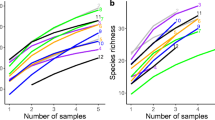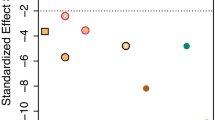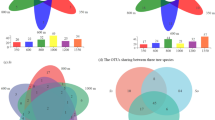Abstract
Arbuscular mycorrhizal (AM) fungi are mutualists with plant roots that are proposed to enhance plant community diversity. Models indicate that AM fungal communities could maintain plant diversity in forests if functionally different communities are spatially separated. In this study we assess the spatial and temporal distribution of the AM fungal community in a wet tropical rainforest in Costa Rica. We test whether distinct fungal communities correlate with variation in tree life history characteristics, with host tree species, and the relative importance of soil type, seasonality and rainfall. Host tree species differ in their associated AM fungal communities, but differences in the AM community between hosts could not be generalized over life history groupings of hosts. Changes in the relative abundance of a few common AM fungal species were the cause of differences in AM fungal communities for different host tree species instead of differences in the presence and absence of AM fungal species. Thus, AM fungal communities are spatially distinguishable in the forest, even though all species are widespread. Soil fertility ranging between 5 and 9 Mg/ha phosphorus did not affect composition of AM fungal communities, although sporulation was more abundant in lower fertility soils. Sampling soils over seasons revealed that some AM fungal species sporulate profusely in the dry season compared to the rainy season. On one host tree species sampled at two sites with vastly different rainfall, relative abundance of spores from Acaulospora was lower and that of Glomus was relatively higher at the site with lower and more seasonal rainfall.





Similar content being viewed by others
References
Abbott LK, Robson AD (1981) Factors influencing the occurrence of vesicular-arbuscular mycorrhizas. Agric Ecosyst Environ 35:121–150
Alexander I, Ahmad N, See LS (1992) The role of mycorrhizas in the regeneration of some Malaysian forest trees. Phil Trans R Soc Lond Ser B 355:379–388
Allen ED, Rincon E, Allen MF, Perez-Jimenez A, Huante P (1998) Disturbance and seasonal dynamics of mycorrhizae in a tropical deciduous forest in Mexico. Biotropica 30:261–274
Allen MF (1991) The ecology of mycorrhizae. Cambridge University Press, New York
Bever JD (1994) Feedback between plants and their soil communities in an old field community. Ecology 75:1965–1977
Bever JD (1999) Dynamics within mutualism and the maintenance of diversity:inferences from a model of interguild frequency dependence. Ecol Lett 2:52–62
Bever JD (2001) Ecological dynamics within the plant-AM fungal mutualism. Abstract for the Third International Conference on Mycorrhizas, Adelaide, Australia.
Bever JD, Morton JB, Antonovics J, Schultz PA (1996) Host-dependent sporulation and species diversity of arbuscular mycorrhizal fungi in a mown grassland. J Ecol 84:71–82
Bever JD, Westover KM, Antonovics J (1997) Incorporating the soil community into plant population dynamics: the utility of the feedback approach. J Ecol 85:561–573
Bever JD, Schultz PA, Pringle A, Morton JB (2001) Arbuscular mycorrhizal fungi:more diverse than meets the eye, and the ecological tale of why. Bioscience 51:923–931
Biermann B, Linderman RG (1983) Use of vesicular arbuscular mycorrhizal roots, intraradical vesicles and extraradical vesicles as inoculum. New Phytol 95:97–105
Bray JR, Curtis JT (1957) An ordination of the upland forest communities of southern Wisconsin. Ecol Monogr 27:325–349
Breeman N van (1998) (ed) Plant-induced soil changes: processes and feedbacks. Kluwer, Dordrecht
Brundrett MC (1991) Mycorrhizas in natural ecosystems. In: MacFayden A, Begon M, Fitter AH (eds) Advances in ecological research, vol 21. Academic Press, London, pp 171–313
Brundrett MC, Abbott LK (1994) Mycorrhizal fungal propagules in the Jarrah forest I. Seasonal study of inoculum levels. New Phytol 127:539–546
Brundrett, MC, Abbott LK, Jasper DA (1999) Glomalean mycorrhizal fungi from tropical Australia. I. Comparison of the effectiveness and specificity of different isolation procedures. Mycorrhiza 8:305–314
Clark DB, Clark DA (1992) Life history diversity of canopy and emergent trees in a neotropical rainforest. Ecol Monogr 62:315–344
Clark DB, Clark DA (2000) Landscape-scale variation in forest structure and biomass in a tropical rain forest. For Ecol Manage 137:185–198
Clark JS, Macklin E, Wood L (1998) Stages and spatial scales of recruitment limitation in southern Appalachian forests. Ecol Monogr 68:213–235
Clarke KR (1993) Non-parametric multivariate analyses of changes in community structure. Aust J Ecol 18:117–143
Clarke KR, Warwick RM (1994) Change in marine communities: an approach to statistical analysis and interpretation. National Environment Research Council, UK
Coen E (1983) Climate. In: Janzen D (ed) Costa Rican natural history. University of Chicago Press, Chicago, Ill., pp 35–46
Coley PD, Barone JA (1996) Herbivory and plant defenses in tropical forests. Annu Rev Ecol Syst 27:305–335
Cuenca G, Menedes E (1996) Diversity patterns of arbuscular mycorrizal fungi associated with cacao in Venezuela. Plant Soil 183:315–322
Daniels BA, Menge JA (1980) Hyperparasitization of vesicular arbuscular mycorrhizal fungi. Phytopathology 70:584–588
Daniels BA, Skipper HD (1982) Methods for the recovery and quantitative estimation of propagules from soil. In: Schenck NC (ed) Methods and principles of mycorrhizal research. American Phytopahtological Society Press, St. Paul, Minn., pp 29–3
Egerton-Warburton LM, Allen EB (2000) Shifts in arbuscular mycorrhizal communities along an anthropogenic nitrogen deposition gradient. Ecol Appl 10:484–496
Eom A -H, Hartnett DC, Wilson GWT (2000) Host plant species effects on arbuscular mycorrhizal fungal communities in tallgrass prairie. Oecologia 122:435–444
Faith DP, Minchin PR, Belbin L (1987) Compositional dissimilarity as a robust measure of ecological distance. Vegetatio 69:57–68
Field JG, Clarke KR, Warwick RM (1982) A practical strategy for analysing multispecies distribution patterns. Mar Ecol Progr Ser 8:37–52
Francis R, Read DJ (1994) The contributions of mycorrhizal fungi to the determination of plant community structure. Plant Soil 159:11–25
Gange AC, Brown VK, Sinclair GS (1993) Vesicular-arbuscular mycorrhizal fungi: a determinant of plant community structure in early succession. Funct Ecol 7:616–622
González G, Seastedt TR (2001) Soil fauna and plant litter decomposition in tropical and subalpine forests. Ecology 4:955–964
Grime JP, Mackey ML, Hillier SH, Read DJ (1987) Floristic diversity in a model system using experimental microcosms. Nature 328:420–422
Guadarrama P, Alvarez-Sanchez FJ (1999) Abundance of arbuscular mycorrhizal fungi spores in different environments in a tropical rain forest, Veracruz, Mexico. Mycorrhiza 8:267–270
Hartshorn GS (1983) Plants, Introduction. In: Janzen D (ed) Costa Rican natural history. University of Chicago Press, Chicago, Ill., pp 118–157
Hartshorn GS, Hammel BE (1994) Vegetation types and floristic patterns. In: McDade LA, Bawa KS, Hespenheide HA, Hartshorn GS (eds) La Selva: ecology and Natural history of a neotropical rain forest. University of Chicago Press, Chicago, Ill., pp 73̫89
Hazlett D (1987) Seasonal cambial activity for Pentaclethra, Goethalsia, and Carapa trees in a Costa Rican lowland forest. Biotropica 19:357–360
Heijden MGA van der, Boller T, Wiemken A, Sanders IR (1998a) Different arbuscular mycorrhizal fungal species are potential determinants of plant community structure. Ecology 79:2082–2091
Heijden MGA van der, Klironomos JN, Ursic M, Moutoglis P, Streitwolf-Engel R, Boller T, Wiemken A, Sanders IR (1998b) Mycorrhizal fungal diversity determines plant biodiversity, ecosystem variability and productivity. Nature 396:69–72
Helgason T, Daniel TJ, Husband R, Fitter A, Young JPY (1998) Ploughing up the wood-wide web. Nature 394:431
Howeler RH, Sieverding E, Saif S (1987) Practical aspects of mycorrhizal technology in some tropical crops and patures. Plant Soil 100:249–283
Husband R, Herre EA, Turner SL, Gallery R, Young JPW (2002) Molecular diversity of arbuscular mycorrhizal fungi and patterns of host association over time and space in a tropical forest. Mol Ecol 11:2669–2678
Janos DP (1980a) Mycorrhizae influence tropical succession. Biotropica [Suppl] 12:56–64
Janos DP (1980b) Vesicular-arbuscular mycorrhizae affect lowland tropical rain forest plant growth. Ecology 61:151–162
Janos DP (1983) Tropical mycorrhizas, nutrient cycles and plant growth. In: Sutton SL, Whitmore TC, Chadwick AC (eds) Tropical rain forest: ecology and management. Blackwell, Oxford, pp 327–345
Janos DP, Trappe JM (1982) Two new Acaulospora species from tropical America. Mycotaxon 15:515–522
Janos DP, Sahley CT, Emmons LH (1995) Rodent dispersal of vesicular-arbuscular mycorrhizal fungi in Amazonian Peru. Ecology 76:1852–1858
Johnson NC (1993) Can fertilization of soil select less mutualistic mycorrhizae? Ecol Appl 3:749–757
Johnson NC, Wedin DA (1997) Soil carbon, nutrients, and mycorrhizae during conversion of dry tropical forest to grassland. Ecol Appl 7:171–182
Johnson NC, Tilman D, Wedin D (1992) Plant and soil controls on mycorrhizal fungal communities. Ecology 73:2034–2042
Johnson NC, Graham JH, Smith FA (1997) Functioning of mycorrhizas along the mutualism-parasitism continuum. New Phytol 135:1–12
Kiers ET, Lovelock CE, Krueger EL, Herre EA (2000) Differential effects of tropical arbuscular mycorrhizal fungal inocula on root colonization and tree seedling growth:implications for tropical forest diversity Ecol Lett 3:106–113
Klironomos JN (1995) Arbuscular mycorrhizae of Acer saccharum in different soil types. Can J Bot 73:1824–1830
Klironomos JN, Kendrick WB (1996) Palatability of microfungi to soil arthropods in relation to the functioning of arbuscular mycorrhizae. Biol Fertil Soils 21:43–52
Klironomos JN, Moutoglis P, Kendrick B, Widden P (1993) A comparison of spatial heterogeneity of vesicular-arbuscular mycorrhizal fungi in two maple-forest soils. Can J Bot 71:1472–1480
Klironomos JN, McCune J, Hart M, Neville J (2000) The influence of arbuscular mycorrhizae on the relationship between plant diversity and productivity. Ecol Lett 3:137–141
Kruskal JB (1964) Multidimensional scaling by optimizing goodness of fit to a nonmetric hypothesis. Psychometrika 29:1–27
Lee PJ, Koske RE (1994) Gigaspora gigantean:parasitism of spores by fungi and actinomycetes. Mycol Res 98:458–466
Lieberman D, Lieberman M (1987) Forest tree growth and dynamics at La Selva, Costa Rica (1969–1982). J Trop Ecol 3:347–358
Lieberman D, Lieberman M, Hartshorn G, Peralta R (1985) Growth rates and age-size relationships of tropical wet forest trees in Costa Rica. J Trop Ecol 1:97–109
Louis L, Lim G (1987) Spore density and root colonization of vesicular-arbuscular mycorrhizas in tropical soil. Trans Br Mycol Soc 88:207–212
Lovelock CE, Miller R (2002) Heterogeneity in inoculum potential and effectiveness of arbuscular mycorrhizal fungi. Ecology 83:823–832
Mangan SA, Adler GH (2002) Seasonal dispersal of arbuscular mycorrhizal fungi by spiny rates in a neotropical forest. Oecologia 131:587–597
Merryweather J, Fitter AH (1998a) The arbuscular mycorrhizal fungi of Hyacinthoides non-scripta. I. Diversity of fungal taxa. New Phytol 138:117–129
Merryweather J, Fitter AH (1998b) The arbuscular mycorrhizal fungi of Hyacinthoides non-scripta. II. Seasonal and spatial patterns of fungal populations. New Phytol 138:131–142
Minchin PR (1987) An evaluation of relative robustness of techniques for ecological ordination. Vegetatio 69:89–107
Mills KE, Bever JD (1998) Maintenance of diversity within plant communities:soil pathogens as agents of negative feedback. Ecology 79:1595–1601
Morton JB (1998) Taxonomy of VA mycorrhizal fungi: classification, nomenclature and identification. Mycotaxon 32:267–324
Morton JB, Bentivenga SB (1994) Levels of diversity in endomycorrhizal fungi (Glomales, Zygomycetes) and their role in defining taxonomic and non-taxonomic groups. Plant Soil 159:47–59
Morton JB, Bentivenga SP, Wheeler WW (1993) Germplasm in the International Collection of Arbuscular Mycorrhizal Fungi (INVAM) and procedures for culture development, documentation and storage. Mycotaxon 48:491–528
Morton JB, Bentivenga SP, Bever JD (1995) Discovery, measurement and interpretation of diversity in symbiotic endomycorrhizal fungi (Glomales, Zygomycetes). Can J Bot [Suppl] 73:S25-S32
Moutoglis P, Widden P (1996) Vesicular-arbuscular mycorrhizal spore populations in sugar maple (Acer saccharum Marsh. L.) forests. Mycorrhiza 6:91–97
Musoko M, Last FT, Mason PA (1994) Populations of spores of vesicular-arbuscular mycorrhizal fungi in undisturbed soils of secondary deciduous moist tropical forests in Cameroon. For Ecol Manage 63:359–377
Newsham KK, Fitter AH, Watkinson AR (1995) Multi-functionality and biodiversity in arbuscular mycorrhizas. Trends Ecol Evol 10:407–411
Packer A, Clay K (2000) Soil pathogens and spatial patterns of seedling mortality in a temperate tree. Nature 404:278–281
Pavlis J, Jenik J (2000) Roots of pioneer trees in the Amazonian rain forest. Trees: structure and function. 14:442–455
Picone C (2000) Diversity and abundance of arbuscular-mycorrhizal fungal spores in tropical forest and pasture. Biotropica 32:734–747
Rees M, Condit R, Crawley M, Pacala S, Tilman D (2001) Long-term studies of vegetations dynamics. Science 293:650–655
Rhoades CC, Sanford RL, Clark DB (1994) Gender dependent influences on soil phosphorus by the dioecious lowland tropical tree Simarouba amara. Biotropica 26:362–368
Ribbens E, Silander JA, Pacala SW (1994) Seedling recruitment in forests:calibrating models to predict patterns of tree seedling dispersion. Ecology 75:1794–1806
Sieverding E (1989) Ecology of VAM fungi in tropical agrosystems. Agriculture, Ecosyst Environ 29:369–390
Sollins P, Sancho FM, Mata Ch. R, Sanford RL (1994) Soils and soil process research. In: McDade LA, Bawa KS, Hespenheide HA, Hartshorn GS (eds), La Selva: ecology and Natural history of a neotropical rain forest. University of Chicago Press, Chicago, Ill., pp 34–53
Stutz JC, Morton JB (1996) Successive pot cultures reveal high species richness of arbuscular endomycorrhizal fungi in arid ecosystems. Can J Bot 74:1883–1889
Stutz JC, Copeman R, Martin CA, Morton JB (2000) Patterns of species composition and distribution of arbuscular mycorrhizal fungi in arid regions of southwestern North America and Namibia, Africa. Can J Bot 78:237–245
Whitmore TC (1984) Tropical rain forests of the Far East. Clarendon Press, Oxford
Wright SJ (2002) Plant diversity in tropical forests: a review of mechanisms of species coexistence. Oecologia 130:1–14
Zangaro W, Bononi VLR, Truffen SB (2000) Mycorrhizal dependency, inoculum potential and habitat preference of native woody species in South Brazil. J Trop Ecol 16:603–622
Acknowledgements
We thank Rachel Tenni, Gerardo Vega, Giselle Alvarez and Gilberto Hernandez Lopez for their assistance in the field. The Organization for Tropical Studies provided logistic support. The study was supported by the Scholarly Studies Program of the Smithsonian Institution, the National Science Foundation award DBI-0129791 to INVAM, and partially by NSF awards DEB-0129038 and DEB-010838. We especially thank Deborah and David Clark for their advice on tree species, access to their unpublished data and stimulating discussions.
Author information
Authors and Affiliations
Corresponding author
Rights and permissions
About this article
Cite this article
Lovelock, C.E., Andersen, K. & Morton, J.B. Arbuscular mycorrhizal communities in tropical forests are affected by host tree species and environment. Oecologia 135, 268–279 (2003). https://doi.org/10.1007/s00442-002-1166-3
Received:
Accepted:
Published:
Issue Date:
DOI: https://doi.org/10.1007/s00442-002-1166-3




